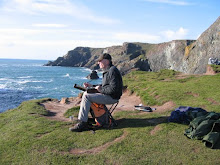

The following is the lesson for painting with acrylics course and is as follows
Lesson 3
Techniques
This week we will look at some of the creative watercolour techniques of John Blockley and use his painting as a reference for exploring watercolour techniques using acrylic paints.
Colours: Cobalt blue, Ultramarine blue, Cadmium red, yellow ochre, burnt umber and white. Soft brush, wax candle, blade, and a palette knife.
I. Lightly plan the drawing but only pencil in the main 4 foreground trees. Indicate the fence and collapsed wall and path. To create a resist, use the candle to work within these shapes, trees rocks, fence and path. It is best to press too hard rather than not enough as we can always scrape paint off back to the wax if there is plenty on.
2. Work a really light wash of cobalt and cadmium red over the background for the distant sky. When this is damp indicate distant trees with cobalt blue mix a little deeper than the sky.
3. When the sky is dry work on the foreground with the warm colours. Paint in more distinct background trees to suggest middle distance.
4. Using darker mixes of burnt umber, cobalt and a palette knife paint in the foreground trees with sideways strokes from the outer edge into the tree and soften some edges with a wet brush. Do one tree at a time. Vary the dark mixes with burnt umber and ultramarine or green, get a little dark variety.
5. Strengthen the foreground working on dark areas around the wall and suggest the path etc. Work wet in wet wet on dry get a variety of interesting edges. Use the end of the brush in wet paint to suggest grasses, blot out part of the wet paint to get a variety of tones, do this over the rocks if they are becoming lost. Flick and spatter colour to suggest small flowers stone or leaves, nature is far from neat.
5. Start to add some accents. When the paint is dry try scraping some of the colour back and adding more wax or a different tone over what you have gone. Use a small blade or knife edge and lay some dark grasses, especially where the land meets the sky. Lighten the distant path with a dilute white mix. Thicker white can be used on the lower part of the sky to emphasise the trees more.
Have another go at home remember, wax resist, scraping back, spattering working wet in wet and wet on dry will give you a variety of textures and edges, experiment, that’s where discoveries are made.





















